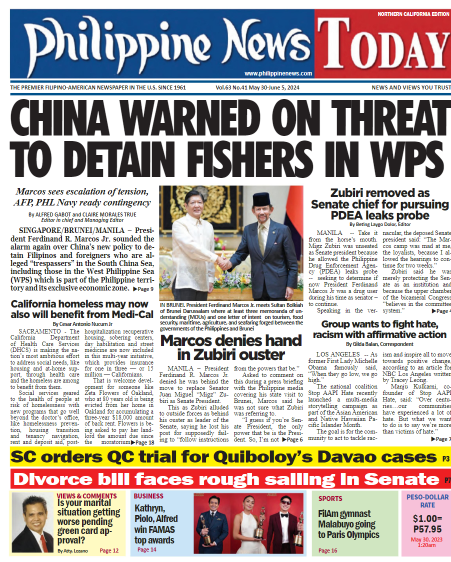CHINA TARGETS EDCA BASES WITH SUPERSONIC MISSILES; AFP acts, NSC says no imminent threat
By ALFRED GABOT and CLAIRE MORALES TRUE
Editor in Chief and Managing Editor
MANILA – The Philippines and China have reaffirmed their commitment to de-escalating tensions in the South China Sea but, while holding their dialogue, Sen. Imelda “Imee” Marcos warned on China’s supposed plan to use hypersonic missiles targeting at least 25 military bases of the Philippines and the United States, including those in Ilocos Norte, Batanes and Cagayan, as China’s biggest Coast Guard vessel called the “Monster” returned to Ayungin Shoal in the West Philippine Sea.
As the Armed Forces of the Philippines (AFP) vowed to look into Sen. Marcos claim, the National Security Council (NSC) said so far it sees “no threat of any imminent attack” from China with the hypersonic missiles.
“Regarding Senator Imee Marcos’ statement about 25 areas potentially targeted by China’s hypersonic missiles due to EDCA (Enhanced Defense Cooperation Agreement) sites and the West Philippine Sea scenario, the AFP takes such concerns seriously. We are ready to coordinate with Senator Marcos to obtain details and take appropriate actions to ensure our nation’s security,” AFP spokesperson Col. Francel Margareth Padilla said.
“We will reach out to Senator Imee to get more information about her statement because we are not aware of any of the security threats she mentioned,” NSC Assistant Director General Jonathan Malaya as he noted agreement of the two nations to de-escalate tension in the South China Sea and West Philippine sea.
In February last year, President Marcos granted the US access to four more Philippine military camps on top of the five existing locations under the EDCA – the Naval Base Camilo Osias in Sta. Ana, Cagayan; Lal-lo Airport in Lal-lo, Cagayan; Camp Melchor Dela Cruz in Gamu, Isabela; and Balabac Island in Palawan.
The first five EDCA locations were Basa Air Base in Pampanga, Fort Magsaysay in Nueva Ecija, Lumbia Air Base in Cagayan de Oro, Antonio Bautista Air Base in Palawan, and Mactan Benito Ebuen Air Base in Cebu.
In a post on X (formerly Twitter), former US Air Force official and former Defence Attaché Ray Powell said the CCG 5901 has joined CCG 5203 in Ayungin Shoal as of 7:26 a.m.
“The 165-meter China Coast Guard 5901 (‘The Monster’) has returned for another intrusive patrol in the Philippines’ exclusive economic zone and has just joined the 102-meter CCG 5203 at 2nd Thomas (Ayungin) Shoal,” Powell said.
Sen. Marcos, chairperson of the Senate Foreign Relations Committee, claimed that the hypersonic missiles will target all 25 EDCA sites in the country.
“”Dahil sa tingin ng Tsina, talagang kumampi na tayo sa kalaban nila… May nakita ako na plano ng Tsina na gagamitin yung hypersonic missile. Ang plano air, ang plano ay yung hypersonic missile at nakatakda na yung 25 na target nila,” Marcos said in a video posted on Facebook page.
Sen Marcos said China’s move is allegedly in response to the Philippines’ approval of the EDCA, which allowed the United States to set up sites in the country for the use of Filipino and American military units and ongoing tensions in the West Philippine Sea.
“Sa pagbabasa natin, may mga missile na sa Batanes, pati sa Subic, so ‘yung dalawang ‘yun ang uunahin kasama ng Ilocos, kasi may mga live-fire na Balikatan. Kakatakot nga eh, ano ba yan, bente singko ah, hindi biro ‘yun (Based on what we read, there are missiles in Batanes and in Subic, so those two would be the first targets together with Ilocos because of Balikatan live-fire drills. It’s scary, what is that, we are talking of 25 here, that is not a joke),” the presidential sister said in a video.
Hypersonic missiles are weapons capable of flying toward their target with speeds of five to 25 times the speed of sound, and are hard to track and intercept with ordinary air defense systems, according to experts.
The Philippines and China agreed on de-escalating tension during their first formal dialogue since the violent skirmish between the Chinese Coast Guard and the Armed Forces of the Philippines near Ayungin Shoal on June 17.
The two states convened the 9th Meeting of their Bilateral Consultation Mechanism on the South China Sea (BCM) in Manila on July 2.
Department of Foreign Affairs (DFA) Undersecretary Ma. Theresa Lazaro and Vice Foreign Minister Chen Xiaodong led the Philippine and Chinese delegations, respectively, and had a “frank and constructive discussions” on the situation.
In her comments, Lazaro told her counterpart that the Philippines would be “relentless in protecting its interests and upholding its sovereignty, sovereign rights, and jurisdiction in the West Philippine Sea.”
“Noting recent incidents in the South China Sea, both sides recognized that there is a need to restore trust, rebuild confidence, and create conditions conducive to productive dialogue and interaction,” the DFA said in a statement.
“The two sides discussed their respective positions on Ayungin Shoal and affirmed their commitment to de-escalate tensions without prejudice to their respective positions,” it added.
The DFA said there was a “substantial progress” on developing measures to manage the situation at sea, but said “significant differences remain.”
The DFA has yet to provide details when asked what kind of measures the Philippines is pushing and what progress has been reached.
Meanwhile, both sides agreed to continue discussions to find a “mutually acceptable resolution” to the issues.
According to the DFA, the two sides signed the Arrangement on Improving Philippines-China Maritime Communication Mechanisms and agreed to discuss further how to operationalize this mechanism.
They also agreed to continue discussions on maritime cooperation between their coast guard authorities, including the possible resumption of the Joint Coast Guard Committee.
The two sides also talked about the possibility of convening an academic forum among scientists and academics on marine scientific and technological cooperation.


















